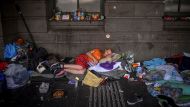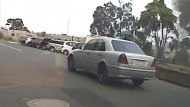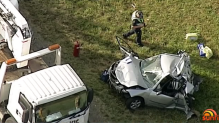I have something of a love-hate relationship with Melbourne. It is by and large a decent place, with a stronger collective sense of society and public amenity than some other big metropolises such as Sydney.
Melbourne has, to use the phrase coined by urban theorist and economist Richard Florida, a vibrant "creative class", something which has partly underpinned its recent success.
More Victoria News Videos
New homeless strategy for Melbourne CBD
Minister for Housing Martin Foley announces a $9.8-million emergency response package to fund immediate housing for the city's street homeless on Thursday.
Even so, I think as a city Melbourne has become badly complacent, coasting on a tired major events schedule, an ageing, overburdened public transport network, and misleading labels such as "the world's most liveable city".
It's time to accept that Melbourne has, over the past decade, lost much of its coveted liveability and no longer deserve the title. Here are five reasons.

1. Melbourne is growing at an unsustainable pace. As it is, one-third of car trips happen on congested roads during the morning peak. The bad news is that it's only going to get worse.
According to Infrastructure Victoria, in coming decades the city is going to become so clogged that the average speed during the morning peak will drop to just 31km/h. And that's even after factoring in billions of dollars worth of planned road and rail upgrades.
Already, it takes about an hour to drive from Epping to the city. In 20 years, add an extra 45 minutes, which is equivalent to more than a working day spent in the car fighting traffic each week.
The costs of this will be huge. There will be obvious imposts, such as lost productivity and leisure time, but also less tangible impacts, such as added pyschological stress. One study linked traffic to negative mental health outcomes, even going so far as to conclude that unexpectedly high traffic could lead to an increase in domestic violence.

2. Crime is rising rapidly. This has created both a perception and a reality: Melbourne is not as safe as it was. According to Victoria's crime statistics agency, the number of offences per 100,000 people leapt by 9.4 per cent over the year to September, and is now 23 per cent more than four years ago.
The increases have been particularly big for offences such as assaults, theft, burglary, and dangerous behaviour. The issue is now such a serious political problem – compounded by failings in youth justice – that law-and-order could potentially derail the Andrews government.

According to an IPSOS poll, in February this year, 52 per cent of people said they were worried about crime, making it the single biggest issue, with the level of concern doubling since the November 2014 election to the highest level ever recorded.
3. Housing affordability has plummeted. To buy an average Melbourne house homebuyers now need about $121,000 for a 20 per cent deposit, compared to just $69,000 a decade earlier.
As Infrastructure Victoria has pointed out, there are up to 100,000 households in Melbourne that have no hope of finding an affordable house anywhere. Rental costs have been rising faster than incomes and are now at record levels, while the number of vacant properties is now falling.
Melbourne has become a city of "haves" and "have-nots", at least when it comes to housing. With about 123,000 people pouring into the state a year, it is a situation that isn't likely to improve significantly, even with the Andrews government's looming housing affordability package.
4. Many state schools are struggling to cope with demand. Victoria may have branded its number plates with an "education state" slogan, but this doesn't mean its schools are particularly well-funded or resourced.
According to the Productivity Commission's latest estimates, each Victorian student gets more than $2000 less in state and federal funding than the national average.
Many public schools are now overcrowded to the point where it is surely compromising educational standards. In about three years, Victorian schools will be teaching one million students.
Some schools, particularly in inner suburbs and areas of booming population growth, have been forced to stagger start times and lunch breaks. Two-storey portables with lifts are now being used.
The government has announced plans for 42 new schools over the next five years, but that won't be enough.The Grattan Institute has estimated that up to 220 new schools will be needed over the next decade in Victoria.
Anxious parents have become so concerned about wildly differing standards many seem to be finding creative ways of enrolling their children in higher performing schools outside their zones. This is, of course, adding to Melbourne's peak hour congestion woes.
5. Victoria's environment has deteriorated. According to a recent review of the state's Environment Protection Agency, population growth is having "profound impacts" on the environment, with increasing waste, noise and pollution and declining air quality.
The claim that Melbourne is the world's most liveable city is intrinsic to the city's psychology. But the measure, from the Economist Intelligence Unit, is largely designed as a tool to allow wealthy expatriates to compare cities.
I don't mean to be unduly negative. Melbourne remains a cool place to live. But it is also just another big city that is rapidly getting bigger, more expensive, more troubled. Underpinning many of these problems are unsustainable rates of population growth. Unless we wake up to this, our problems will only continue to grow.
Josh Gordon is The Age's State Politics editor.















0 comments
New User? Sign up